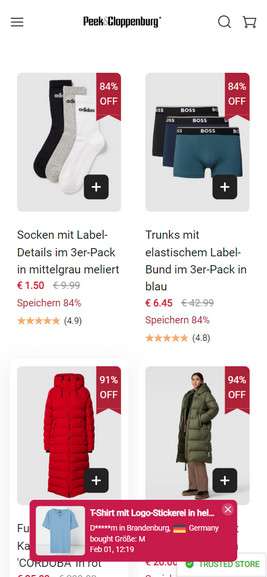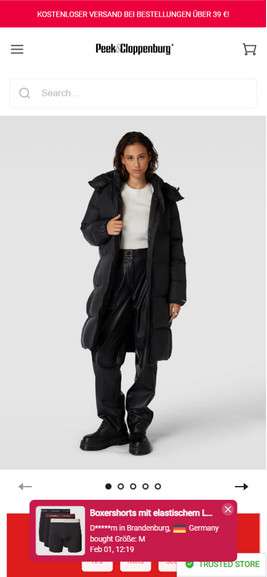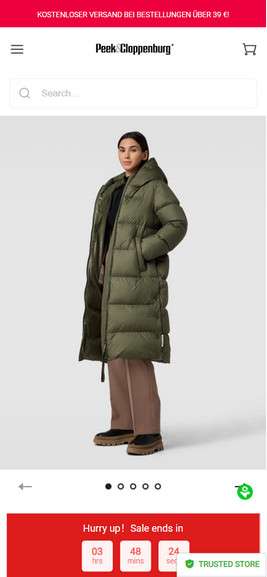Over the past few months, heavily promoted ads on social media for the Peek & Cloppenburg “Clearance Sale” offering items at 90% off have gained a lot of attention. However, behind the tantalizing discounts lies an elaborate scam designed to trick unsuspecting shoppers.
This article will provide an in-depth look at how the scam works, advice for those who have fallen victim, and key things to watch out for to avoid getting ripped off.



Overview of the Peek & Cloppenburg 90% off Scam
Peek & Cloppenburg, also known as P&C, is a popular European fashion retail chain with over 190 stores across Germany, Netherlands, Belgium, Austria, Switzerland, Poland, and other countries. The company sells men’s, women’s, and children’s apparel along with accessories.
However, scammers have been aggressively promoting fake Peek & Cloppenburg websites on social platforms like Facebook, Instagram, and TikTok. They run paid ads to dupe shoppers into thinking they are landing on the real P&C site or an authorized clearance center.
But in reality, these are fraudulent sites loaded with stolen content and huge 90% off deals meant to trick customers into handing over their money for nothing in return.
The scam websites closely imitate the look and feel of the real peekcloppenburg.de site. They prominently feature the P&C logo and brand imagery to appear as a legitimate outlet. The sites list physical addresses and phone numbers as well, but they are completely falsified.
These fake stores are stocked with stolen product photos, descriptions, and pricing directly copied from the real Peek & Cloppenburg e-commerce site. Just enough minor tweaks are made in hopes of avoiding detection.
The fraudsters behind these elaborate fake sites then advertise clearance sales with items discounted up to 90% off. They brazenly promote prices of just €29, €39, or €49 for P&C products that normally retail for €200 or more.
These absurdly low prices are paired with messages like “Warehouse Clearance Sale” and “Outlet Store” in bold fonts alongside countdown timers. This pressures shoppers to jump on the deals before time runs out.
Many victims shopped these scam sites believing the rock-bottom prices were just blowout warehouse clearance offers on excess Peek & Cloppenburg inventory. But sadly, the victims ended up receiving low-quality items far different than advertised – or sometimes nothing at all.
For example, one scam victim reported ordering a nice P&C winter jacket for just €39 but instead received a flimsy thin windbreaker in the mail. Others stated they ordered designer shoes or dresses per the site photos and descriptions but received random products like sunglasses or basic phone cases.
Perhaps the worst scenario is when victims’ credit cards get charged for items that never arrive weeks later. And there is no way for them to contact the scam sites by phone, email, or mail since all info is falsified. Any funds already paid are lost for good in most cases.
These elaborate fake e-commerce stores only operate for short windows before getting taken down and reopened under new domains. This constant shifting of domains and identities makes it incredibly difficult for consumers to get recourse.
It also limits the window to submit credit card chargebacks or complaints to authorities. By the time victims realize they have been scammed, the site has often vanished without a trace along with their money.
The scammers also optimize the fake sites to rank high in search engines when users search for “Peek & Cloppenburg sale.” This brings in more unsuspecting victims. The paid social media ads provide another efficient channel to drive traffic to their fraudulent stores.
While these fake P&C websites may look impressively real at quick glance, there are some red flags consumers can watch for. Suspicious or misspelled URLs, prices that seem way too low, recycled content, missing contact pages, and grammatical errors point to likely scam sites.
How the Peek & Cloppenburg 90% Off Scam Works
Here is a step-by-step look at how this scam operates to dupe online shoppers:
1. Scammers create fake e-commerce websites
The fraudsters will register domain names that incorporate the Peek & Cloppenburg name or similarities like “P&C Outlet” or “P&C Warehouse Sale.” The sites are designed to look like the real P&C website in terms of branding, product images, and overall aesthetics.
This makes it difficult for consumers to discern that they are on an illegitimate site. The scam sites will also list an address and phone numbers to appear more legitimate, but they are not real P&C contact information.
2. Fake sites populated with stolen content
To make the scam websites seem authentic, scammers will steal product descriptions, pricing, photos, and other content directly from peekcloppenburg.de and other retailers.
They use this plagiarized content to populate their fake stores. Most of the time, slight changes are made to the product info or images to avoid detection.
3. Fraudulent sites market clearance sales
The scam websites prominently advertise clearance sales, often with countdown timers to create urgency. Common slogans used include “Warehouse Sale”, “Outlet Store”, and “Limited Time Only.”
False claims of closing down businesses or excess inventory are also used to push the narrative of extreme discounts up to 90% off normal prices. This tricks shoppers into believing they are getting an incredible bargain.
4. Shoppers purchase products at steep discounts
Once the fraudulent websites acquire traffic through ads or search engines, the very low prices lure shoppers into making purchases. The sites will offer popular P&C products like jackets, jeans, dresses, and shirts for €29, €39, or €49 when they normally retail for €200 or more.
The 90%+ discounts are extreme even for clearance items and should be an immediate red flag. However, the professional-looking sites and brand recognition overrides consumer skepticism.
5. Payment processed but no items or low-quality goods shipped
After completing purchases on the fake sites, shoppers will see charges on their credit cards. However, the scammers often either ship nothing or low-cost, shoddy products that look nothing like the images or descriptions.
Some common reports indicate victims receive random used goods like old sunglasses or phone cases instead of the clothes they ordered. This allows the criminals to pocket the money while providing “proof” that an item was shipped.
6. No way to contact fake sites
Once consumers realize they have been scammed, there is usually no way to contact the fake websites. The sites will not have phone numbers, physical addresses, or working customer service email addresses.
This prevents victims from getting refunds or resolving issues. Any money sent is gone, and credit card chargebacks may be the only recourse.
7. Fake sites quickly disappear
To avoid detection and complaints, the fraudulent sites will only operate for a short period of time, often a few weeks or months. Then the scammers take down the sites and reopen new ones under different domains with the same scheme.
This constant cycling through domains makes it hard for consumers to track the scammers or hold them accountable. It also limits the window for complaints and credit card chargebacks.
How to Identify the Fraudulent Peek & Cloppenburg 90% Off Websites
While the fake Peek & Cloppenburg websites advertising huge clearance sales may look convincing, there are several red flags consumers can watch for to avoid getting scammed. Being able to identify the fraudulent sites quickly is key to protecting yourself.
Here are the top signs that a purported P&C site offering steep discounts is likely a scam:
Recently Created Domains
One tell-tale sign is when the domain name was just registered very recently, like within the past few months. Fraudsters constantly have to switch up domains as their scam sites get discovered and shut down. They’ll often use domain names containing some variation of “Peek”, “P&C”, “Cloppenburg”, or abbreviations.
Real brands don’t rapidly cycle through domain names, so new sites should be viewed skeptically. Do a domain lookup to check the creation date.
Lack of Contact Information
Authentic retailers always provide ways for customers to contact them, such as a phone number, email, physical address, and customer service options. Scam sites will often show addresses and numbers that are completely fake just to appear more legitimate.
But there will be no working number or address you can actually use to get in touch with anyone from the site. An email address may be shown, but emails will go unanswered. Real P&C sites have full contact sections.
Unbelievable Discounts of 90% Off
When you see current-season, premium Peek & Cloppenburg apparel and accessories advertised at 70%, 80%, or 90% off retail pricing, it’s too good to be true. Even clearance items on the real site do not get discounted more than 50% typically.
Deep discounts like this are dangled to tempt shoppers but are a dead giveaway of a counterfeit site. The scam stores aren’t selling authentic P&C merchandise, so they mark prices impossibly low to drive purchases.
Template Design and Stolen Images
Another sign is when site designs look like templates rather than unique branding. Product photos may be low-resolution or have watermarks indicating they were swiped from other sites and catalogs.
Scammers rarely bother shooting unique product images and instead steal them in bulk along with product descriptions. Search for some images on Google to see if they appear on other sites.
Enticing but Dubious Slogans
Watch for over-the-top slogans like “Going out of Business Sale!” or “Last Chance for 90% Off!” in large fonts on site headers and product listings. These are tactics to create false urgency.
Other red flag phrases include: “Warehouse Clearance,” “Liquidation Sale,” “Limited Time Only,” and “Inventory Blowout.” Authentic P&C promotions will not use exaggerated wording like this.
Stay vigilant for these warning signs when shopping online. Only purchase directly from Peek & Cloppenburg’s official website at peekcloppenburg.de to avoid falling victim to convincing scam websites promising unbelievable deals. Trust your instincts if something seems off.
Identifying the Scam on Social Media
In addition to fake websites, scammers aggressively promote the Peek & Cloppenburg 90% off scam through social media platforms like Facebook, Instagram, and TikTok. They use paid ads and posts to target deal-seeking users with enticing offers. Here is how to detect their scam content on each platform:
Spotting the Scam on Facebook
- Watch for Facebook ads promoting suspicious P&C discounts up to 90% off. The ads will try luring you to external sites.
- Be wary of Facebook posts showing alleged P&C products at very low prices and urging users to “act fast.”
- Scam posts often use eye-catching phrases like “Blowout Sale,” “Today Only,” or “Wharehouse Clearance” to create urgency.
- Comments may be disabled on scam Facebook posts to prevent warnings from real users exposing the fraud.
- Reverse image search product photos used in questionable Facebook ads or posts to check if they are stolen from real sites.
Detecting the Scam on Instagram
- Scammers run Instagram ads promoting huge P&C discounts to direct users to their fake sites. The items will be absurdly inexpensive.
- Be suspicious of Instagram photos showing the Peek & Cloppenburg logo with claims of “Final Clearance” or similar slogans.
- Fraudulent Instagram accounts will often use AI-generated profile pictures of fake people to look more real.
- Question accounts pushing massive P&C deals that lack followers, posts, or other signs of legitimate engagement.
- The scam Instagram accounts tend to be recently created and only repost product images stolen from authentic sites.
Recognizing the Scam on TikTok
- Scam TikTok accounts post short videos claiming to show “Secret P&C deals!” or “How to get 90% off P&C items.”
- TikTok ads from shady accounts promote Peek & Cloppenburg clearance sales and pressure viewers to buy before the timer runs out.
- AI-generated voiceovers are used on scam TikTok videos about P&C sales to sound more credible. The visuals only show stolen product images.
- Scam TikTok accounts have very few real followers and videos. Comments are also disabled to prevent warnings from others.
- Reverse image searching any product shots can help reveal if they were stolen from authentic sites and used fraudulently.
Stay vigilant across social channels and do not click suspicious links promoting unbelievable P&C deals. Only trust verified official brand accounts and websites. Protect your personal and payment information by avoiding social media scams.
What to Do If You Are a Victim of the Scam
If you have fallen prey to the fake Peek & Cloppenburg clearance scam, here are the steps to take:
1. Contact your credit card company immediately
Notify your credit card provider and request a chargeback for any fraudulent charges. Provide details about the scam and that you never received the items purchased. This starts the chargeback process so the charges can be reversed.
2. Gather all documentation related to the purchase
Collect any emails, receipts, screenshots, order confirmations, tracking numbers, or other details you have related to the scam purchase. This evidence will bolster your chargeback claim and make it more likely to be approved.
3. File complaints
Submit complaints to relevant consumer protection authorities about the website that scammed you so they can investigate further. Help protect others by reporting fake sites whenever possible.
4. Check credit reports
Identity theft is a risk if scammers obtain any personal information from purchases. Monitor your credit reports frequently for any unusual activity and place a fraud alert if needed.
5. Avoid the site in the future
Make sure to add the fraudulent site to your browser’s blocked list and clear cookies/cache to avoid accidental visits in the future. Also search for the site periodically to see if the domain resurfaces.
6. Research sellers carefully
Be diligent in researching online sellers thoroughly before making any purchases to avoid being scammed again. Look for warning signs of fake sites like no contact info, low prices, grammar errors, etc.
7. Spread awareness
Share your experience through consumer forums, social media, or with friends/family to help prevent others from falling for this scam. The more awareness spread, the less victims there will be.
By taking these steps right away and disputing the charges, you have a good chance of recovering lost money. The earlier you act, the better your odds. Do not delay starting the chargeback process if funds were stolen.
Frequently Asked Questions About the P&C Clearance Scam
1. Is the Peek & Cloppenburg 90% off clearance sale real?
No, the huge 90% off Peek & Cloppenburg clearance sales promoted online and on social media are a scam. P&C is a victim of elaborate fraud. The fake sites use stolen P&C branding and content to trick customers.
2. How can I tell if a P&C sale website is fake?
Watch for red flags like prices too low to be real, recently created domains, lack of contact info, stolen images, errors, and exaggerated slogans about closing sales. Only order directly from peekcloppenburg.de.
3. What happens if I order from a fake P&C website?
Most victims either receive low-quality items far different than described, a random cheap product like used sunglasses, or sometimes nothing at all. Your money will be gone.
4. Are the ads for P&C sales on Facebook and Instagram real?
Likely not. Scammers pay for Facebook and Instagram ads to promote the fake 90% off sales and lure victims. Reverse image search any product photos used to check legitimacy.
5. What should I do if I placed an order on a scam website?
Immediately contact your credit card company and request a chargeback. Provide details on the scam and emphasize you never got the ordered product. This can help recover lost funds.
6. How can I report a fake Peek & Cloppenburg website?
Gather website details and screenshots then report the scam site to P&C through their official contact page. Also file a complaint with consumer protection groups so they can investigate fraud sites.
7. Why are these P&C scam sites allowed to operate?
Scammers work hard to avoid detection by frequently switching domain names and identities. By the time one site is discovered, they open a new one. Continued consumer vigilance is key.
8. How can I avoid the Peek & Cloppenburg clearance scam?
Carefully research sellers, look for red flags, read reviews, and only order directly from the real peekcloppenburg.de site. If an offer seems suspiciously cheap, it is likely a scam.
9. Who is behind these fake Peek & Cloppenburg websites?
The scammers remain anonymous, but are likely organized cybercrime groups skilled at creating convincing fake websites and manipulating consumers through social media ads and false discounts.
10. Is it safe to order from the real Peek & Cloppenburg site?
Yes, ordering directly from the official P&C website at peekcloppenburg.de is completely safe. It is the unauthorized fake sites claiming huge discounts that scam victims.
Stay vigilant and educate yourself on the red flags of clearance sale scams to protect your wallet. Only trust the real Peek & Cloppenburg website and customer service.
The Bottom Line
The Peek & Cloppenburg 90% off scam serves as a cautionary tale of just how convincing online retail fraud has become. Savvy scammers are experts at creating authentic looking e-commerce stores filled with stolen content and unrealistic deals. This fools deal-seeking shoppers into paying for goods that never arrive.
Consumers must stay vigilant when shopping online, especially when tempting clearance offers arise. If something seems too good to be true, it almost always is. Carefully research seller legitimacy, look for scam red flags, and stick to trusted retailers to avoid trouble. With a few prudent precautions, you can enjoy online shopping while safely avoiding scams.










